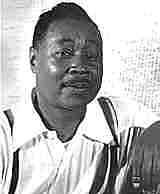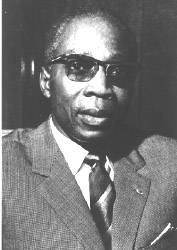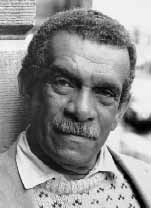
Claude MacKay. Look at "Tropics in New York." Each stanza represents a different movement. In the first there is what is seen, lyrically evocative of the tropics (for McKay, of Jamaica). The second stanza shows the move from the fruit in the window to the landscape of the tropical home. Note how the stanza telescopes out, showing a wider vista of the tropics with each line. Stanza three shows the emotional impact on the speaker--the sense of loss in the present what is recoverable in memory.

Leopold Senghor,Poet, statesman, one of the founders of the ideas of the Negritude movement. Look at the affirmation of the black aesthetic in a line from "Black Woman": "Nude woman, black woman/ I sing your disappearing beauty, fixing it in an Eternal shape,/ Befor an envious destiny transforms you into ashes to nourish the roots of life." And look at the positive aspects of the pan-African when he urges "New York! I say New York, let black blood flow into your blood. Let it wash the rust from your steel joints, like an oil of life/ Let it give your bridges the curve of hips and supple vines."
Hear Senghor read his poem "Femme Nue, Femme Noir"
James Baldwin, “Encounter on the Seine: Black Meets Brown,” (671-76).
Derek
Walcott Nobel Prize Winner. Heralded for his utilizing of sophisticated
poetic techniques to evoke the consciousness of the Caribbean. Often,
for him, it is a divided consciousness due to his mixed-race heritage,
his sympathies for the abject poor of the Caribbean, and his love of the
great works of weste (English language) culture.
"A Far Cry from Africa" chronicles the kinds of contradictions
in his consciousness asking, in the long run, "how choose/ Between
this Africa and the English tongue I love?" "Volcano" empoys
the two beacons that Joseph Conrad uses at the end of a novel, Victory,
comparing them to the two beacons he finds in the work of Joseph Conrad
and James Joyce--"There were giants in those days."
We spent most of our time on the longer, complex story of "The Fortunate
Traveler," that traveller over the globe who works in name for the
relief of suffering of the "10,000,000 shoreless souls," but
who in reality feels a great guilt due to the fact that there is profit
to be made from the work.
There is the image of "the square coffin manacled to my wrist"
(line 7) What is inside that coffin? What is this "coffin" as
metaphor?
The mystery behind line 25--"A tug. Smoke trailing its dark cry."
(Does this have something to do with the "hooked worm"?
Lines in the 40's, using statistics, etc., to reduce the suffering individual
to numers and statistics. Becomes an even more bold distancing from human
suffering when, starting line 95, the speaker: "I thought, who cares
how many million starve"
Part 2 uses images from the holocaust, including the concept behind Lebenstraum.
Also, our old iconographic friend Kurtz makes an appearance to help rredefine
the heart of darkness.
We have the chillling (for us in E 316K) allegation that "everywhere
the earth shows its rib cage and the moon goggles with the eyes of children,
we turn away to read." (lines 174-76).
Might think of all the insect metaphors with which the poem ends, as well
as the insect imagery inside the poem.
